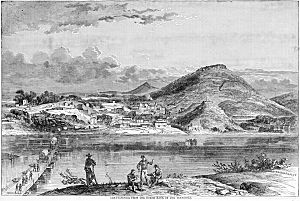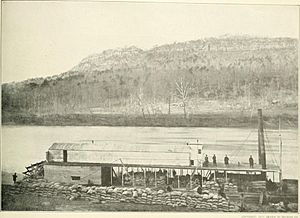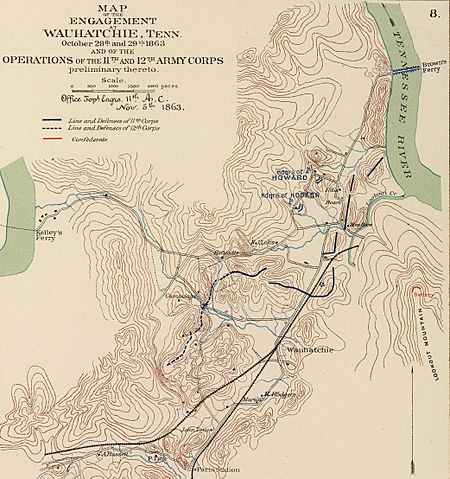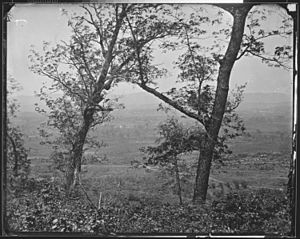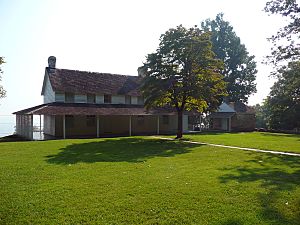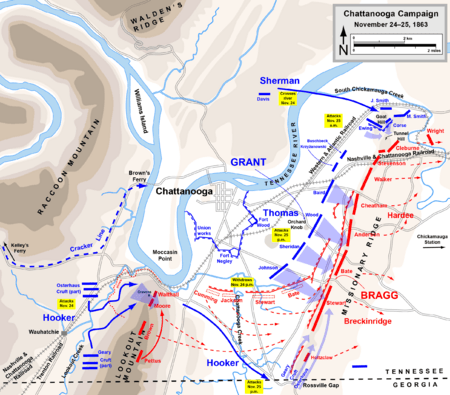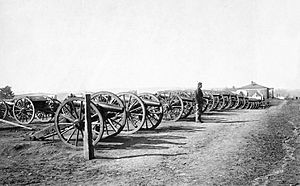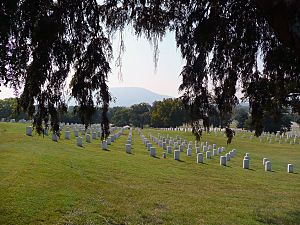Chattanooga campaign facts for kids
Quick facts for kids Chattanooga campaign |
|||||||
|---|---|---|---|---|---|---|---|
| Part of the American Civil War | |||||||
 Maj. Gen. Ulysses S. Grant and Gen. Braxton Bragg, commanding generals of the Chattanooga campaign |
|||||||
|
|||||||
| Belligerents | |||||||
| Commanders and leaders | |||||||
| Ulysses S. Grant William S. Rosecrans George Henry Thomas William Tecumseh Sherman Joseph Hooker |
Braxton Bragg | ||||||
| Units involved | |||||||
|
Military Division of the Mississippi: |
Army of Tennessee | ||||||
| Strength | |||||||
| 72,533 "present for duty equipped" | 48,948 "present for duty" | ||||||
| Casualties and losses | |||||||
| 5,824 total
(753 killed
4,722 wounded 349 missing) |
6,000–8,000 (estimated) (8,684 men killed, wounded or prisoners) |
||||||
The Chattanooga campaign was a series of important battles and movements during the American Civil War in October and November 1863. After the Union Army of the Cumberland lost the Battle of Chickamauga in September, the Confederate Army of Tennessee, led by General Braxton Bragg, surrounded the Union forces in Chattanooga, Tennessee. They did this by taking over key high ground around the city.
Major General Ulysses S. Grant was put in charge of all Union forces in the western part of the war. He brought many more soldiers to Chattanooga. On October 18, Grant replaced Major General William Rosecrans with Major General George Henry Thomas as the commander of the Army of the Cumberland.
A new supply route, called the "Cracker Line," was opened to bring food to the starving Union soldiers and animals. On October 28–29, a Union force under Major General Joseph Hooker fought off a Confederate attack at the Battle of Wauhatchie. On November 23, the Union Army moved out from Chattanooga and captured a small hill called Orchard Knob. At the same time, Union soldiers under Major General William Tecumseh Sherman prepared a surprise attack on Bragg's right side at Missionary Ridge.
On November 24, Sherman's troops crossed the Tennessee River and took high ground on the northern part of Missionary Ridge. That same day, Hooker's forces defeated the Confederates at the Battle of Lookout Mountain. The next day, Hooker's men moved toward Bragg's left side at Rossville.
On November 25, Sherman's attack on Bragg's right side did not make much progress. To help Sherman, Grant ordered Thomas's army to attack the Confederate positions at the bottom of Missionary Ridge. The Union soldiers then pushed all the way to the top of the ridge, forcing the Confederate Army of Tennessee to retreat. They were chased by Union troops but managed to fight them off at the Battle of Ringgold Gap. Bragg's defeat meant the Confederates lost control of Tennessee. This victory opened the way for the Union to invade the Deep South, leading to Sherman's Atlanta campaign in 1864.
Contents
Why Chattanooga Was Important
A Key City in the War
Chattanooga was a very important city during the Civil War. It was a major railroad hub, with train lines going to Nashville, Knoxville, and Atlanta. It was also a key place for making iron and coal. Plus, the Tennessee River flowed through it, making it easy to move goods by boat.
In September 1863, the Union Army, led by Major General William Rosecrans, forced Confederate General Braxton Bragg to leave Chattanooga and go into northern Georgia. Rosecrans followed Bragg, and the two armies fought at the Battle of Chickamauga on September 19–20. Bragg won a big victory when a mistake opened a gap in the Union line. Confederate Lieutenant General James Longstreet's troops rushed through and defeated a large part of the Union army.
Major General George Henry Thomas made a strong stand on Snodgrass Hill, which saved the Union army from being completely destroyed. This earned him the nickname "Rock of Chickamauga." Most of Rosecrans's army was able to retreat safely to Chattanooga. Bragg did not cut off their escape routes or chase them, which allowed the Union army to regroup and set up strong defenses around the city.
The Siege of Chattanooga
Bragg's army surrounded Chattanooga, hoping to starve the Union forces into giving up. The Confederates set up positions on Missionary Ridge and Lookout Mountain. From these high spots, they had excellent views of the city, the Tennessee River, and the Union's supply lines.
Bragg chose to lay siege because attacking the strong Union defenses would have been too costly. He also had problems with his own generals. Some of his top generals complained to Confederate President Jefferson Davis, asking for Bragg to be removed from command. Davis visited Chattanooga but decided to keep Bragg in charge. Bragg then removed some of the generals who had complained.
In Chattanooga, Rosecrans was very upset by his army's defeat. He seemed unable to make important decisions to break the siege. Union soldiers began to run out of food, and many of their horses and mules died. The only supply route not controlled by the Confederates was a long, difficult path over Walden's Ridge. Heavy rains made the roads even worse. In early October, Confederate cavalry attacked a Union supply train, burning wagons and killing mules. By the end of October, Union soldiers were getting very little food.
 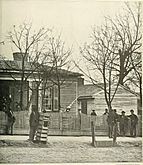 |
| Grant and Thomas headquarters, October 23. |
The Union leaders quickly started planning to help Chattanooga. Secretary of War Edwin M. Stanton sent Major General Joseph Hooker with 20,000 soldiers from Virginia. Major General Ulysses S. Grant was also ordered to send his troops from Mississippi. On September 29, Stanton put Grant in charge of all Union forces in the West. Grant was given the choice to replace Rosecrans, and he chose Major General Thomas. Grant told Thomas to "Hold Chattanooga at all hazards." Thomas famously replied, "I will hold the town till we starve." Grant arrived in Chattanooga on October 23.
Opening the Cracker Line
A New Supply Route
The Union army's chief engineer, Brigadier General William Farrar Smith, came up with a plan to open a better supply line. General Thomas immediately started putting the plan into action. Grant liked the plan too. The idea was to capture Brown's Ferry, which crossed the Tennessee River. From there, a road led through Lookout Valley to Kelley's Ferry, where Union supply boats could reach. If the Union could control this route, a reliable supply line, soon called the "Cracker Line," would be open.
Hooker's troops were ordered to move quickly to Lookout Valley. However, bad weather delayed them. Grant decided to go ahead with the Brown's Ferry operation even before Hooker arrived. On the morning of October 27, Union soldiers floated quietly downriver on boats, surprising the Confederates. They captured the area around Brown's Ferry by 4:40 a.m. A Confederate counterattack was pushed back. The Confederate general, Longstreet, did not think the Union move was important and did not tell Bragg. When Bragg found out, he ordered Longstreet to retake the area, but Longstreet did nothing.
Hooker's column marched through Lookout Valley and met up with the other Union forces at Brown's Ferry on October 28. The "Cracker Line" was now open, and supplies could finally reach the Union soldiers in Chattanooga.
Battle of Wauhatchie
Bragg ordered Longstreet to attack Hooker's troops at Wauhatchie. Hooker had not set up his forces in good defensive positions. He had sent one division, led by Brigadier General John W. Geary, to protect the supply line. Longstreet saw Geary's soldiers and their wagons parked right in front of him.
Longstreet ordered a night attack, which was unusual in the Civil War. The attack started at midnight on October 28. Geary's men were surprised but quickly formed a V-shaped battle line. Hearing the fighting, Hooker sent reinforcements. The battle was confusing in the dark. Longstreet's men were outnumbered, but they held a strong position on a hilltop.
Eventually, Longstreet's forces pulled back. Both sides had made mistakes in planning. Hooker's carelessness had put his men at risk. Grant was not happy with Hooker's actions. Bragg was also unhappy with Longstreet for not committing enough soldiers to the attack.
Longstreet Leaves
Opening the "Cracker Line" completely changed the situation. Bragg knew the siege was broken. He decided to send Longstreet and his two divisions to East Tennessee to fight against another Union force under Major General Ambrose Burnside near Knoxville. This weakened Bragg's army in Chattanooga, but he hoped it would help the Confederates in Knoxville.
Preparing for the Big Battle
Grant had two weeks before Sherman's troops arrived. He told Thomas and Smith to plan an attack on Bragg. The plan was for Sherman to cross the Tennessee River and attack Bragg's right side on Missionary Ridge. If successful, the Union would control the railroad lines that supplied Bragg's army, forcing him to leave. Thomas's army would also attack the Confederate center on Missionary Ridge. The plan also called for Hooker to attack and capture Lookout Mountain, Bragg's left side.
Sherman arrived on November 14. He thought he could capture the end of Missionary Ridge easily. Grant approved the plan. However, Sherman's troops were still far away because they had been ordered to repair railroads as they marched. This delayed the attack. Grant was also getting pressure from Washington to help Burnside in Knoxville.
Bragg had sent most of his cavalry away, so he didn't have much information about Union movements. He thought Sherman's troops were going to Knoxville, not Chattanooga. So, he believed the main Union attack would be on his left side, Lookout Mountain. He put Major General Carter L. Stevenson in charge of defending the mountain.
Confederate soldiers on Missionary Ridge were also unhappy. Their line was very long, and they didn't have enough men to defend it well. On November 22, Bragg made things worse by sending Major General Patrick Cleburne's division to Knoxville, removing 11,000 more men from Chattanooga's defense.
Union and Confederate Forces
Union Army Commanders
| Union subordinate commanders |
|---|
|
The Union forces at Chattanooga were led by Major General Ulysses S. Grant. They included:
- The Army of the Tennessee, led by Major General William T. Sherman.
- The Army of the Cumberland, led by Major General George Henry Thomas.
- A special command under Major General Joseph Hooker, which included parts of other corps.
Confederate Army Commanders
| Confederate corps commanders |
|---|
|
Bragg's Army of Tennessee had these main forces in Chattanooga:
- Longstreet's Corps, led by Lieutenant General James Longstreet. (This corps was sent to Knoxville on November 5).
- Hardee's Corps, led by Lieutenant General William J. Hardee.
- Breckinridge's Corps, led by Major General John C. Breckinridge.
On November 5, Bragg sent Longstreet's Corps to fight Major General Ambrose Burnside near Knoxville. On November 22, Bragg sent another division to Knoxville, further weakening his army in Chattanooga.
The Battles for Chattanooga
Taking Orchard Knob
On November 23, the Union army saw Confederate soldiers marching away from Missionary Ridge. They also heard from Confederate deserters that the whole army might be leaving. Grant worried that Bragg was sending many soldiers to help Longstreet in Knoxville. He wanted to stop this movement.
Thomas ordered his division to advance and see how strong the Confederate line was. His men saw a small hill, 100 feet high, called Orchard Knob, about 2,000 yards away. About 14,000 Union soldiers quickly moved forward. They surprised the 600 Confederate defenders, who could only fire one shot before being defeated.
Grant and Thomas decided to keep the captured position and dig in. Orchard Knob became Grant's and Thomas's headquarters for the rest of the battles. Bragg quickly called back all his units that were nearby. Cleburne's division returned after dark. Bragg also moved some troops from Lookout Mountain to Missionary Ridge.
The Battle Above the Clouds
Grant's original plan for November 24 was for Hooker to just hold Lookout Valley. But Hooker now had about 10,000 men. Thomas allowed Hooker to make a strong attack on Lookout Mountain. Hooker ordered his men to cross Lookout Creek and attack the mountain, sweeping away any Confederates.
Hooker's troops moved along the base of Lookout Mountain. They pushed back the Confederate defenders to the Cravens House, just below the northern end of the mountain. Confederate soldiers on the mountain top could not help the fight below.
By about 3:00 p.m., a thick fog covered the mountain. A Union officer called this the "Battle Above the Clouds." The two sides fired blindly in the fog, but few men were hit. Hooker predicted that the Confederates would leave that night. He was right. At midnight, the fog cleared, and the Confederate divisions retreated, burning the bridges behind them.
That night, Bragg asked his commanders if they should retreat or fight. One general suggested retreating, but Breckinridge convinced Bragg to fight on Missionary Ridge. So, the troops from Lookout Mountain were sent to the right side of Missionary Ridge.
Storming Missionary Ridge
On the morning of November 24, Sherman's three divisions crossed the Tennessee River. They took what Sherman thought was the north end of Missionary Ridge, but it was actually a separate hill. Sherman saw that the Confederates had strong defenses on Tunnel Hill, the true northern part of the ridge. Sherman ordered his men to dig in.
On November 25, Grant's plan was for Sherman to keep attacking Missionary Ridge from the north. Thomas's army would support him by attacking the Confederate center. Hooker's job was to distract Bragg by moving toward Rossville Gap. As the morning went on, Sherman attacked Cleburne's line on Tunnel Hill many times, but he made little progress. At the southern end, Hooker's advance was slowed for hours because the bridges over Chattanooga Creek had been burned.
Seeing that the attacks on the sides were not working, Grant ordered Thomas to advance in the center around 3:30 p.m. The soldiers of the Army of the Cumberland quickly pushed the Confederates out of their rifle pits at the base of the ridge. But then they faced heavy fire from the Confederate positions higher up the ridge. Many of Thomas's troops had been at the terrible defeat at Chickamauga and had been teased by Sherman's and Hooker's new forces. Now, they were under fire from above with no clear plan.
At this point, the Union soldiers, on their own, decided to keep attacking. They surged up the slope to find shelter from the fire. Bragg had placed his artillery and trenches on the very top of the ridge, not on the "military crest" (a slightly lower point that allows guns to fire down the slope). This meant the Confederate guns could not fire effectively at the Union soldiers climbing up. The Union advance was messy but very effective. They completely overwhelmed the Confederate line, which should have been impossible to break.
The Army of the Cumberland's climb up Missionary Ridge was one of the most amazing events of the war. Historians say it was the most famous example of a direct attack succeeding against strong defenses on high ground. A Union officer remembered that soldiers rushed forward, carrying their flags, even if the flag bearer fell.
Grant was initially angry that his orders to stop at the rifle pits had not been followed. Thomas was also surprised. But the attack worked! By 4:30 p.m., the center of Bragg's line had completely broken. The Confederates fled in a panic, abandoning Missionary Ridge and retreating eastward. Only Cleburne's division managed to form a rearguard and cover Bragg's retreat.
Rossville Gap
After leaving Lookout Mountain, Major General Joseph Hooker's command moved east. They faced a big problem: the bridge over Chattanooga Creek had been burned. The creek was high, so it took about three hours to rebuild a bridge and cross. Hooker finally reached Rossville Gap at 3:30 p.m.
Breckinridge, who was in charge of that part of the Confederate line, was worried about his left side. He ordered some regiments to hold Rossville Gap, but it was too late. Hooker's men had already marched through. Hooker quickly turned his troops north and attacked. He sent forces along the ridge and its sides. The Confederates fought back, but they were outnumbered. Many of them surrendered.
Retreat and Aftermath
During the night, Bragg ordered his army to retreat toward Dalton, Georgia. Only Union General Sheridan tried to chase them, but he gave up when he realized he wasn't getting support.
Ringgold Gap
The Union pursuit was stopped at the Battle of Ringgold Gap. At 3 a.m. on November 27, Cleburne's Confederate men waited until the Union force was very close before opening fire. Major General Joseph Hooker's troops were completely surprised. Hooker tried to outflank the Confederates, but they held their ground. For five hours, the fighting continued. Cleburne's 4,100 soldiers held off Hooker's 12,000. Cleburne's men stayed until about noon, then retreated, allowing the Confederate wagons and artillery to escape safely.
Grant called off the rest of the pursuit because his army was low on food. Also, Washington was still pushing him to rescue Burnside in Knoxville. President Lincoln's message to Grant after Missionary Ridge said, "Well done. Many thanks to all. Remember Burnside."
What Happened Next
The Union Army had about 5,824 casualties (soldiers killed, wounded, or missing) out of 56,000 engaged. Bragg reported 6,667 Confederate casualties, mostly prisoners.
One of the Confederacy's two main armies was completely defeated. Bragg resigned from command of the Army of Tennessee on December 1. General Joseph E. Johnston took over later that month.
In East Tennessee, Longstreet's attack on Burnside at Knoxville failed on November 29. Grant sent Sherman with 25,000 men to help Burnside. Longstreet ended his siege on December 4 and returned to Virginia in the spring of 1864.
The Confederate hopes that had been so high after Chickamauga were crushed at Chattanooga. The Union now had full control of Tennessee, including Chattanooga, which was called the "Gateway to the Lower South." The city became a major supply base for Sherman's Atlanta campaign in 1864. Grant won his last battle in the West before becoming the commander of all Union armies in March 1864.
Protecting the Battlefield
Parts of the Chattanooga battlefields, including 3,000 acres at Lookout Mountain, are protected by the National Park Service as part of the Chickamauga and Chattanooga National Military Park. The American Battlefield Trust and its partners have also helped save 120 acres of the battlefield.
See also
 In Spanish: Batalla de Chattanooga para niños
In Spanish: Batalla de Chattanooga para niños


